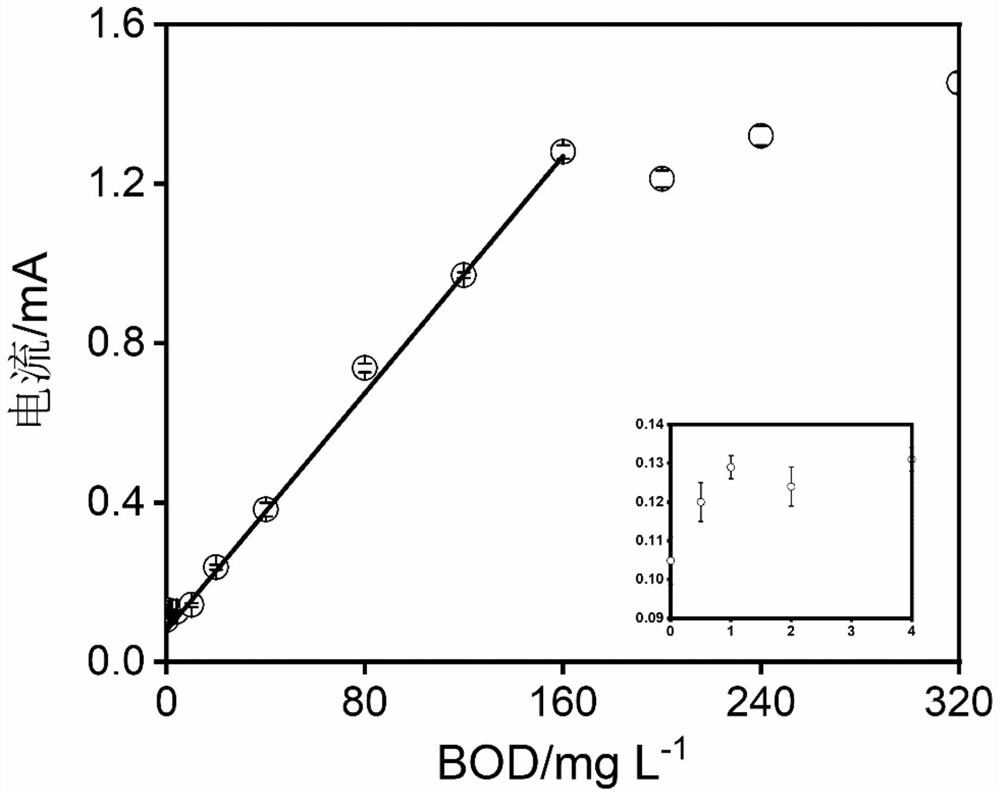A bioelectrochemical method for real-time in situ detection of BOD in organic wastewater
A technology of bioelectrochemistry and organic wastewater, applied in the direction of material electrochemical variables, measuring devices, scientific instruments, etc., can solve the problems of increased BOD, decreased accuracy and stability of biosensors, etc., and achieve shortened test time and high test accuracy Effect
- Summary
- Abstract
- Description
- Claims
- Application Information
AI Technical Summary
Problems solved by technology
Method used
Image
Examples
Embodiment 1
[0068] Using the sludge water of the anoxic section of the sewage treatment plant as the inoculum, the bioelectrode for the detector was cultivated in the MFC mode:
[0069] An external resistor 18 is connected between the anode and the cathode of the bioelectrochemical reactor, and the loop is connected with copper wires to construct a microbial dye battery reactor (ie, an MFC reactor) 16, such as Pic 4-1 shown. The MFC reactor was inoculated with sludge water in the anoxic section. The inoculation process lasted for five days, and then it was transferred to the sequencing batch mode for cultivation, and the matrix solution was changed every day. The voltage of the MFC was recorded by a digital data collection instrument (KEYSIGHT model 34970A).
[0070] specific:
[0071] The reactor configuration with a cubic two-chamber structure was constructed into a bioelectrochemical reactor. The anode chamber 14 of the reactor had an inner diameter of 35 mm, a length of 40 mm and a...
Embodiment 2
[0077] The response current curve generated by the LSV (ie linear sweep voltammetry) scan of the bioelectrode in the solution containing the fixed organic components with different BOD concentrations (here, the sodium acetate solution is used as an example), the most suitable one is selected according to the curve data. The BOD detection process signal output potential.
[0078] After the electrode biofilm is matured, the external resistance of the MFC reactor is removed, and the bioelectrochemical reactor (including the mature bioelectrode and reference electrode placed in the anode compartment, and the counter electrode placed in the cathode compartment) are connected with the potentiostat. connected to construct a bioelectrochemical sensor 17, such as Figure 4-2 shown.
[0079] The bioelectrochemical reactor was connected with a potentiostat in a three-electrode system, graphite electrode (bioelectrode) 12, foamed nickel air electrode 13 and silver / silver chloride electro...
Embodiment 3
[0082] Taking the present invention as the detection method of the bioelectrochemical sensor in the fixed organic component BOD solution (taking sodium acetate solution as an example), the detection mark is measured:
[0083] The bioelectrochemical reactor was connected with a potentiostat in a three-electrode system, graphite electrode (bioelectrode), foamed nickel air electrode and silver / silver chloride electrode were used as working electrode, counter electrode and reference electrode, respectively. by adding 12.5mL -1 Trace Minerals and 5mL L -1 The standard BOD-containing solution was prepared by adding sodium acetate to 50mM PBS of vitamins, and the concentration of the standard BOD solution was set to 0.5mgBOD L respectively. -1 , 1mgBOD L -1 , 2mgBOD L -1 , 4mgBOD L -1 , 10mgBOD L -1 , 20mgBOD L -1 ,40mgBOD L -1 ,80mgBOD L -1 ,100mgBOD L -1 ,120mgBOD L -1 , 160mgBOD L -1 , 200mgBOD L -1 , 240mgBOD L -1 and 320mg BOD L -1 . The current at -0.1V potential...
PUM
| Property | Measurement | Unit |
|---|---|---|
| length | aaaaa | aaaaa |
| volume | aaaaa | aaaaa |
| length | aaaaa | aaaaa |
Abstract
Description
Claims
Application Information
 Login to View More
Login to View More - R&D
- Intellectual Property
- Life Sciences
- Materials
- Tech Scout
- Unparalleled Data Quality
- Higher Quality Content
- 60% Fewer Hallucinations
Browse by: Latest US Patents, China's latest patents, Technical Efficacy Thesaurus, Application Domain, Technology Topic, Popular Technical Reports.
© 2025 PatSnap. All rights reserved.Legal|Privacy policy|Modern Slavery Act Transparency Statement|Sitemap|About US| Contact US: help@patsnap.com



